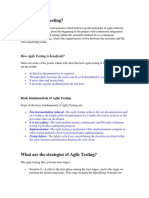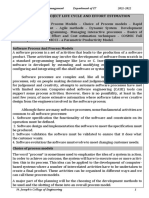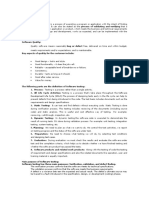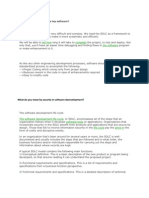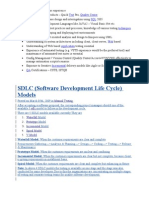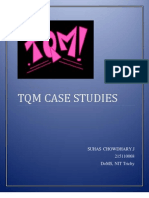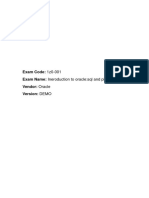Doc
Doc
Uploaded by
Sripriya Venkatesh PrasadCopyright:
Available Formats
Doc
Doc
Uploaded by
Sripriya Venkatesh PrasadCopyright
Available Formats
Share this document
Did you find this document useful?
Is this content inappropriate?
Copyright:
Available Formats
Doc
Doc
Uploaded by
Sripriya Venkatesh PrasadCopyright:
Available Formats
61.
Testing for design phase: Design Analysis Testing (DAT) Evaluates correct implementation of the design intent, and requires intimate knowledge of the design detail. Performed by designers, or dedicated group of DAT testers. Typically tightly coupled to designers. Verifies that implementation is correct as intended and meets requirements. In addition, allows designers to exercise design in extreme ways. White box testing. Design Verification Testing (DVT) Demonstrates that specified requirements have been met. Typically performed by independent group, sometimes called QA, especially in SW word. Verifies design to requirements. Black box testing. Design validation 1.Demonstrates that the system conforms to user needs and intended uses. 2.Performed by independent group, or more likely, the designers and system engineers. 62. Software Testing Methodologies These are some commonly used software testing methodologies: Waterfall model V model Spiral model RUP Agile model RAD Waterfall Model The waterfall model adopts a 'top down' approach regardless of whether it is being used for software development or testing. The basic steps involved in this software testing methodology are: Requirement analysis Test case design Test case implementation Testing, debugging and validating the code or product Deployment and maintenance In this methodology, you move on to the next step only after you have completed the present step. There is no scope for jumping backward or forward or performing two steps simultaneously. Also, this model follows a non-iterative approach. The main benefit of this methodology is its simplistic, systematic and orthodox approach. However, it has
many shortcomings since bugs and errors in the code are not discovered until and unless the testing stage is reached. This can often lead to wastage of time, money and valuable resources. V Model The V model gets its name from the fact that the graphical representation of the different test process activities involved in this methodology resembles the letter 'V'. The basic steps involved in this methodology are more or less the same as those in the waterfall model. However, this model follows both a 'top-down' as well as a 'bottom-up' approach (you can visualize them forming the letter 'V'). The benefit of this methodology is that in this case, both the development and testing activities go hand-in-hand. For example, as the development team goes about its requirement analysis activities, the testing team simultaneously begins with its acceptance testing activities. By following this approach, time delays are minimized and optimum utilization of resources is assured. Spiral Model As the name implies, the spiral model follows an approach in which there are a number of cycles (or spirals) of all the sequential steps of the waterfall model. Once the initial cycle is completed, a thorough analysis and review of the achieved product or output is performed. If it is not as per the specified requirements or expected standards, a second cycle follows, and so on. This methodology follows an iterative approach and is generally suited for very large projects having complex and constantly changing requirements. Rational Unified Process (RUP) The RUP methodology is also similar to the spiral model in the sense that the entire testing procedure is broken up into multiple cycles or processes. Each cycle consists of four phases namely; inception, elaboration, construction and transition. At the end of each cycle, the product or the output is reviewed and a further cycle (made up of the same four phases) follows if necessary. Today, you will find certain organizations and companies adopting a slightly modified version of the RUP, which goes by the name of Enterprise Unified Process (EUP). Agile Model This methodology follows neither a purely sequential approach nor does it follow a purely iterative approach. It is a selective mix of both of these approaches in addition to quite a few new developmental methods. Fast and incremental development is one of the key principles of this methodology. The focus is on obtaining quick, practical and visible outputs and results, rather than merely following theoretical processes. Continuous customer interaction and participation is an integral part of the entire development process. Rapid Application Development (RAD) The name says it all. In this case, the methodology adopts a rapid development approach by using the principle of component-based construction. After understanding the various requirements, a rapid prototype is prepared and is then compared with the expected set of output conditions and standards. Necessary changes and modifications are made after
joint discussions with the customer or the development team (in the context of software testing). Though this approach does have its share of advantages, it can be unsuitable if the project is large, complex and happens to be of an extremely dynamic nature, wherein the requirements are constantly changing. 63.Tools For software Acceptance Testing: Acceptance Testing is the formal testing conducted to determine whether a software system satisfies its acceptance criteria and to enable buyer to determine whether to accept the system or not.Acceptance testing is designed to determine whether software is fit for use or not. Apart from functionality of application, other factors related to business environment also plays an important role. List of acceptance-testing frameworks FitNesse, a fork of Fit Framework for Integrated Test (Fit) iMacros ItsNat Java Ajax web framework with built-in, server based, functional web testing capabilities. Ranorex Selenium (software) Test Automation FX Watir 64.Benefits Of Software Testing: 1) Software testing discovers if critical functionality works. This is helpful to know when your trying to sell something (Im assuming!) 2) Software testing makes sure that your product doesnt negatively affect interacting systems. I suspect this helps encourage repeat sales. 2) It provides tangible results which can be used to sell the product. For example, you can use your proven high performance as a selling point 3) It demonstrates delivery from a contractual perspective through acceptance testing 4) It gives confidence to those selling the product. There is added benefit in knowing the product your selling works. 5) Certification can provide business a selling point. If your system conforms to a technical standard, it may help your product to be perceived as reliable. 6) Early fault detection reduces the cost of fault detection. The earlier a defect is found, the less development rework and re-test is required, minimising its implementation cost. 7)I t delivers efficiencies in the software development process through metrics such as root cause analysis . These detect possible areas of improvement for software development. 8) Software testing is the source of information such as defect reports, metrics and results that assist IT perform their roles efficiently. Project managers rely on metrics to report on progress, operations, on tangible results to extrapolate future hardware requirements and developers on defect reports to fix their code. 9)Manual testing is cost effective.
10)More random type of testing can be done in manual testing. 65.Test Strategy A test strategy is an outline that describes the testing portion of the software development cycle. It is created to inform project managers, testers, and developers about some key issues of the testing process. This includes the testing objective, methods of testing new functions, total time and resources required for the project, and the testing environment.Test strategies describes how the product risks of the stakeholders are mitigated at the test-level, which types of test are to be performed, and which entry and exit criteria apply. They are created based on development design documents. System design documents are primarily used and occasionally, conceptual design documents may be referred to. Design documents describe the functionality of the software to be enabled in the upcoming release. For every stage of development design, a corresponding test strategy should be created to test the new feature sets. 66.Test Data In most cases, multiple sets of values or data are used to test the same functionality of a particular feature. All the test values and changeable environmental components are collected in separate files and stored as test data. It is also useful to provide this data to the client and with the product or a project. 67.Primary objectives of testing during design phase is to: 1.Verify if the design is good,testable,efficient,compact and maintainable. 2.Verify if the design meets the requirements and is complete.(i.e specifies all the relationships between modules,how to pass data,what happens in exceptional circumstances, starting state of each module etc.). 3.verify if the design incorporates sufficient memory , i/o devices and quick enough runtime for the future product. 68. Need For Software Maintenance Maintenance is the last stage of the software life cycle. After the producthas been released, the maintenance phase keeps the software up to date with environment changes and changing user requirements. As software systems age, it becomes increasingly difficult to keep them up and runningwithout maintenance. Systems must also be adapted to changing environments and user requirement needs.In fact, a substantial proportion of the resources expended within the Information Technology industry goes towards the maintenance of software systems. 69. Four steps in selecting the app. Software testing tool: 1. What is the type of my project? Is it a stand-alone project or a client server project?
2. What is the size of my project? You can find size on various metrics like kilo line of code. 3. Is there repeated work in my project? 4. Time taken for My current Manual project testing 5. Error rate by Manual testing. 70.Cost Of Testing: Project planners have cost estimation models (COCOMO model) ,which they use to estimate overall project cost The test planner can use the COCOMO model to estimate total project costs ,and then allocate fraction of these costs for test. Roper suggest a fractional value of about 50% of total project costs. Testing costs = 0.5*total project costs. Total project cost includes: 1.costs of planning and designing the tests. 2.cost of acquiring the hardware and software necessary for the tests. 3.cost to support the test environment 4.cost of executing the tests. 5.cost of recording and analyzing test results. 6.tear-down costs to restore the environment 7.cost of training the testers and maintaining the test database. 71.Inspection Plan Inspection Plan describes how a quality inspection of one or several materials is to take place. The inspection plan contains information about the sequence of inspection operations and the range of specifications available for inspecting inspection characteristics.Inspection plan can be used to inspect materials using standard processes. You can also inspect several materials with one inspection plan, or one material with several inspection plans. 72.Spiral Testing In the spiral development environment, software testing is again described as a continuous improvement process that must be integrated into a rapid application development methodology. Testing as an integrated function prevents development from proceeding without testing. 73.Test Metrics 1.Provide an objective measurement of the success of the software project. 2.Are a standards of measurement. 3.Gauge the effectiveness and efficiency of several software development activities. 4.Are gathered and interpreted throughout the SDLC life cycle. 74. Testing methods The box approach
Software testing methods are traditionally divided into white- and black-box testing. These two approaches are used to describe the point of view that a test engineer takes when designing test cases. White box testing White box testing is when the tester has access to the internal data structures and algorithms including the code that implement these. Black box testing Black box testing treats the software as a "black box"without any knowledge of internal implementation. Black box testing methods include: equivalence partitioning, boundary value analysis ,decision table testing ,cost effect graphing ,state transition testing ,syntax testing . Gray Box Testing: Grey box testing involves having knowledge of internal data structures and algorithms for purposes of designing the test cases, but testing at the user, or black-box level. Manipulating input data and formatting output do not qualify as grey box, because the input and output are clearly outside of the "black-box" that we are calling the system under test. This distinction is particularly important when conducting integration testing between two modules of code written by two different developers, where only the interfaces are exposed for test. However, modifying a data repository does qualify as grey box, as the user would not normally be able to change the data outside of the system under test. Grey box testing may also include reverse engineering to determine, for instance, boundary values or error messages. 75.Methodologies of software testing: 1.Testing begins at module level and works outwars towards the integeration of entire computer based systems. 2.Different testing techniques are required at different points in testing. 3.Testing is conducted by the software developer,third party people or independent test groups. 4.Testing and debugging are 2 different activities and debugging is also necessary. 76.Methods for developing the strategies for testing Test cases should be designed such that 1. It reveals all defects 2. It evaluates the software performance ,usability and reliability Effective test cases ensures: 1.there is a greater probability of deteting defects 2more efficient use of organizational resources 3a higher probability of test reuse 4closer adherence to testing and project schedules and budgets
5possibility of delivering high quality software. 77.Software testing is a process of executing a program with the intent of finding errors.It spans through the entire software development lifecycle(SDLC). Software testing can be stated as the process of validating and verifying that a software program/application/product: meets the requirements that guided its design and development; works as expected; and can be implemented with the same characteristics.
78. Error Detection: Testing should intentionally attempt to make things go wrong to determine if things happen when they shouldnt or things dont happen when they should. Test to break strategy/idea is to implemented to overcome all possible errors. 79. Volume Testing Volume Testing belongs to the group of non-functional tests, which are often misunderstood and/or used interchangeably. Volume testing refers to testing a software application with a certain amount of data. This amount can, in generic terms, be the database size or it could also be the size of an interface file that is the subject of volume testing. For example, if you want to volume test your application with a specific database size, you will expand your database to that size and then test the application's performance on it. 80.Boundary value analysis: Many Defects occur on and above and below the edges of the equivalence classes.Boundary value analysis is a testing strategy which test at these boundaries of the equivalence classes on both the input and the output spaces.Tester selects elements close to the edges ,so that both the upper and the lower edges of the equivalence class are covered by test cases.
You might also like
- SAP S - 4HANA For International Trade - SAP BlogsDocument10 pagesSAP S - 4HANA For International Trade - SAP BlogsArslan King100% (1)
- SQA Interview Preparation by Umar ArshadDocument91 pagesSQA Interview Preparation by Umar ArshadumarNo ratings yet
- Automated Software Testing Interview Questions You'll Most Likely Be AskedFrom EverandAutomated Software Testing Interview Questions You'll Most Likely Be AskedNo ratings yet
- 4.8.2 - Game Architecture and DesignDocument2 pages4.8.2 - Game Architecture and DesignPranil NandeshwarNo ratings yet
- Problem-Solution Essay Cybercrime Final DraftDocument3 pagesProblem-Solution Essay Cybercrime Final Draftapi-462582296No ratings yet
- Software Tester Basics Interview Question and AnswersDocument19 pagesSoftware Tester Basics Interview Question and AnswersÂRUN àNo ratings yet
- Manual Testing Interview Questions Jan 2023Document19 pagesManual Testing Interview Questions Jan 2023Jagannath kNo ratings yet
- What Is Agile TestingDocument17 pagesWhat Is Agile TestingDredz27No ratings yet
- Unit-6 Agile 7TH Sem CseDocument39 pagesUnit-6 Agile 7TH Sem CseNavdeep KhubberNo ratings yet
- Agile Testing Method Simplified - Software Testing Times - Tutorials, QTP, Manual Testing Automation Testing, Load RunnerDocument4 pagesAgile Testing Method Simplified - Software Testing Times - Tutorials, QTP, Manual Testing Automation Testing, Load Runnerbhagwansingh22No ratings yet
- Embedded Systems Design 10EC74Document17 pagesEmbedded Systems Design 10EC74Utkarsh Money earningNo ratings yet
- Unit 2Document35 pagesUnit 2lavanya2webNo ratings yet
- Unit Ii Project Life Cycle and Effort Estimation: IT8075-Software Project Management Department of IT 2021-2022Document35 pagesUnit Ii Project Life Cycle and Effort Estimation: IT8075-Software Project Management Department of IT 2021-2022zoeNo ratings yet
- - PARVEZ MOHAMMAD SHARIAR- 朴维 - Course PaperDocument10 pages- PARVEZ MOHAMMAD SHARIAR- 朴维 - Course PaperparvezNo ratings yet
- What Is Agile?: Agile Model Waterfall ModelDocument9 pagesWhat Is Agile?: Agile Model Waterfall Modelmohd shanuNo ratings yet
- Agile TestingDocument5 pagesAgile TestingAman YadavNo ratings yet
- New Manual NotesDocument68 pagesNew Manual NotesrathodshriNo ratings yet
- Se NotesDocument4 pagesSe NotesYashavanth B ANo ratings yet
- What Is Agile TestingDocument7 pagesWhat Is Agile Testingsharan kommiNo ratings yet
- Agile Testing Method SimplifiedDocument3 pagesAgile Testing Method SimplifiedRaghu NandanNo ratings yet
- Chapter 1Document57 pagesChapter 1Sourabh RautNo ratings yet
- SDLCDocument4 pagesSDLCDada DildadaNo ratings yet
- Testing Techniques in Agile Frameworks: A Study of User Acceptance TestingDocument8 pagesTesting Techniques in Agile Frameworks: A Study of User Acceptance TestingRaghav RathiNo ratings yet
- 5 Marks ST Important QuestionsDocument12 pages5 Marks ST Important QuestionsRuchita MaaranNo ratings yet
- Chapter 2Document22 pagesChapter 2ChetanNo ratings yet
- A Software Testing Process Can Produce Several ArtifactsDocument4 pagesA Software Testing Process Can Produce Several ArtifactsSiti Maryam KazimNo ratings yet
- Testing PDFDocument15 pagesTesting PDFSenthil RajendranNo ratings yet
- Se-13 MarksDocument41 pagesSe-13 MarksPAVANNo ratings yet
- CH 8 QuestionsDocument5 pagesCH 8 QuestionsjeffkinardNo ratings yet
- Corporate Material For Manual TestingDocument94 pagesCorporate Material For Manual TestingVinay GowdaNo ratings yet
- What Is Software Testing? and Difference Between Testing and QA?Document32 pagesWhat Is Software Testing? and Difference Between Testing and QA?Santhosh RaoNo ratings yet
- ST - Unit 1 to 5Document148 pagesST - Unit 1 to 5ss8357619No ratings yet
- Software Project Management Unit - 2 NotesDocument20 pagesSoftware Project Management Unit - 2 Notesshrey.bhaskar.it.2021No ratings yet
- Unit - IDocument13 pagesUnit - IxyzNo ratings yet
- Software Development Life CycleDocument6 pagesSoftware Development Life CycleEverestNo ratings yet
- Lab 2Document10 pagesLab 2Chauhan AkanshaNo ratings yet
- Software Testing For Project ReportDocument15 pagesSoftware Testing For Project ReportKamal AcharyaNo ratings yet
- Software Engg Chap 04Document70 pagesSoftware Engg Chap 04jagruti.patilNo ratings yet
- Illustrate The Umbrella Activities of A Software ProcessDocument12 pagesIllustrate The Umbrella Activities of A Software ProcessGautham SajuNo ratings yet
- SPM Unit 2Document22 pagesSPM Unit 2shubhshubham616No ratings yet
- VASHU SHARMA - SOFTWARE TESTING LAB FILEDocument30 pagesVASHU SHARMA - SOFTWARE TESTING LAB FILEdevvats657No ratings yet
- 4 - Ppt-HciDocument17 pages4 - Ppt-Hcirheena espirituNo ratings yet
- SPM NotesDocument131 pagesSPM Notesp rajeshwariNo ratings yet
- Introduction To Agile TestingDocument3 pagesIntroduction To Agile TestingMohit GargNo ratings yet
- Unit 1Document15 pagesUnit 1Ahmed KhanNo ratings yet
- Software Development Practices: 12/08/2021 S.G.NambuwasamDocument42 pagesSoftware Development Practices: 12/08/2021 S.G.Nambuwasamlankasiriyadownload100% (1)
- Lecture No. 9 + 10Document20 pagesLecture No. 9 + 10ahmadpasha976No ratings yet
- Principles, V-Model and Limitations of Software TestingDocument7 pagesPrinciples, V-Model and Limitations of Software TestingJhanvi PathakNo ratings yet
- Relation To Methods and TheoriesDocument18 pagesRelation To Methods and TheoriesMercy Santôsildes DaracanNo ratings yet
- Skill Development Practical FileDocument18 pagesSkill Development Practical FileAnupriya JainNo ratings yet
- Software Engineering Model (AutoRecovered)Document8 pagesSoftware Engineering Model (AutoRecovered)Aisha KhanNo ratings yet
- Chapter IIDocument26 pagesChapter IIPooja SawantNo ratings yet
- Software Testing All Questions and AnswersDocument98 pagesSoftware Testing All Questions and AnswersSeun -nuga DanielNo ratings yet
- What Is SDLCDocument5 pagesWhat Is SDLCRishi GuptaNo ratings yet
- STLC - Software Testing Life CycleDocument31 pagesSTLC - Software Testing Life CycleSatish987No ratings yet
- SPM Unit 2 NotesDocument19 pagesSPM Unit 2 NotesDr. Sonia Setia (SET Assistant Professor)No ratings yet
- The Likelihood of An Adverse Event and The Impact of The EventDocument65 pagesThe Likelihood of An Adverse Event and The Impact of The EventchitraNo ratings yet
- The Main Software Testing Methodologies and ApproachesDocument5 pagesThe Main Software Testing Methodologies and ApproachesAdnan SamiNo ratings yet
- SDLC (Software Development Life Cycle) Models: Test Quality Center SQL TechniquesDocument5 pagesSDLC (Software Development Life Cycle) Models: Test Quality Center SQL TechniquesgaidhaniNo ratings yet
- Software Testing Is A Process of Executing A Program or Application With The Intent of FindingDocument9 pagesSoftware Testing Is A Process of Executing A Program or Application With The Intent of Findingmalik ArshNo ratings yet
- Software Testing Interview Questions You'll Most Likely Be AskedFrom EverandSoftware Testing Interview Questions You'll Most Likely Be AskedNo ratings yet
- Cost Estimation in Agile Software Development: Utilizing Functional Size Measurement MethodsFrom EverandCost Estimation in Agile Software Development: Utilizing Functional Size Measurement MethodsNo ratings yet
- A SQLite Tutorial With Python PDFDocument14 pagesA SQLite Tutorial With Python PDFursar100% (1)
- Oracle - DBA Tips CornerDocument67 pagesOracle - DBA Tips Cornershaan_ocpNo ratings yet
- The 16 Top Chess Engine Championship: TCEC16: Reading, UK and Maryland, USADocument12 pagesThe 16 Top Chess Engine Championship: TCEC16: Reading, UK and Maryland, USAAnatoly OlisovNo ratings yet
- CS L06 Strategic Defense02 1599891190158 PDFDocument43 pagesCS L06 Strategic Defense02 1599891190158 PDFamitNo ratings yet
- CA Disk Backup and RestoreDocument2 pagesCA Disk Backup and RestoreAiy AriNo ratings yet
- RTS Slids Lec1Document11 pagesRTS Slids Lec1stephen562001No ratings yet
- Getting Started in ESP826 As An IOTDocument25 pagesGetting Started in ESP826 As An IOTmallikharjunag100% (5)
- Computer NetworksDocument22 pagesComputer NetworksSwati SharmaNo ratings yet
- Q1Document4 pagesQ1Rakesh SinhaNo ratings yet
- Communication Skills Model Ques PaperDocument9 pagesCommunication Skills Model Ques PaperAjith KoushalNo ratings yet
- Jurnal Teknologi: Functional Magnetic Resonance Imaging FOR Autism Spectrum Disorder Detection Using Deep LearningDocument8 pagesJurnal Teknologi: Functional Magnetic Resonance Imaging FOR Autism Spectrum Disorder Detection Using Deep LearningBharat TradersNo ratings yet
- CMR Technical Campus: Computer Science & EngineeringDocument2 pagesCMR Technical Campus: Computer Science & EngineeringbhaskarNo ratings yet
- TQM Cases 1Document33 pagesTQM Cases 1Suhas ChowdharyNo ratings yet
- A 6.1-7.68 GHZ CMOS LC-Voltage Controlled Oscillators (VCO)Document4 pagesA 6.1-7.68 GHZ CMOS LC-Voltage Controlled Oscillators (VCO)dhrubNo ratings yet
- Zuhra S Industry Analysis EssayDocument10 pagesZuhra S Industry Analysis Essayapi-723882489No ratings yet
- Unit 4 - How Technology Change Music IndustryDocument2 pagesUnit 4 - How Technology Change Music IndustryMinh Tri TranNo ratings yet
- Code Blocks SourceForgeDocument2 pagesCode Blocks SourceForgesabar5No ratings yet
- 1Z0 001 DemoDocument10 pages1Z0 001 DemoLakshmi prashath kNo ratings yet
- WEbDriver APIsDocument8 pagesWEbDriver APIsKuldeep KewatNo ratings yet
- JordDocument2 pagesJordHarsh BhimaniNo ratings yet
- Cs 101 Short Notes Lectures 2345Document31 pagesCs 101 Short Notes Lectures 2345Danish Zubair33% (3)
- Lennox - Standard Raspberry Pi Vs Compute ModulesDocument17 pagesLennox - Standard Raspberry Pi Vs Compute ModulesjoshmananiNo ratings yet
- Pcwin-Pck: Instruction ManualDocument142 pagesPcwin-Pck: Instruction ManualCRISENTENANo ratings yet
- Guidance Part F - About Information Delivery Planning - Edition 1 PDFDocument34 pagesGuidance Part F - About Information Delivery Planning - Edition 1 PDFNeedleandMortarNo ratings yet
- Bahasa InggrisDocument9 pagesBahasa Inggris0239 MUHAMAD RIZKYNo ratings yet
- MSC Comp SC Syllabus Cbcs 09072016Document37 pagesMSC Comp SC Syllabus Cbcs 09072016Srinivasa Rao TNo ratings yet
- Online Food Ordering SystemDocument18 pagesOnline Food Ordering SystemAkash GuptaNo ratings yet








